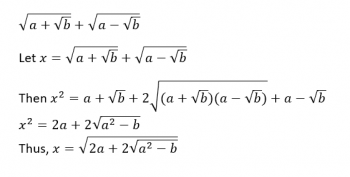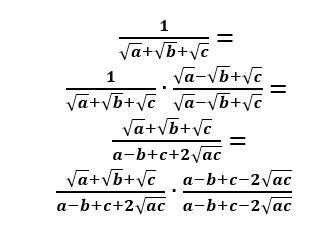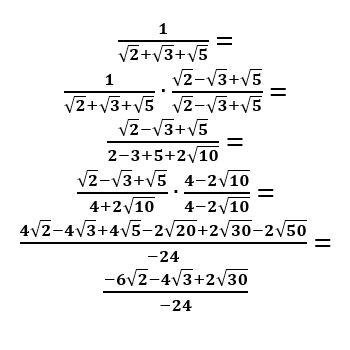Ask Professor Puzzler
Do you have a question you would like to ask Professor Puzzler? Click here to ask your question!
"Sqr(2 + Sqr(3)) + Sqr(2 - Sqr(3)) works out to a simple radical (the square root of six). But not all radical expressions like that are so nice. How can you tell whether it'll simplify?" ~Paul
Hi Paul, whenever I have a question like this, I automatically think, "I'm going to replace the numbers with variables to see what happens."
So I'm going to rewrite your expression with variables, and then start manipulating it algebraically:

Joshua asks, "I heard people say that a sum of two squares is (x + y + sqr(2xy))(x + y - sqr(2xy)) But I also heard that a sum of two squares is (x+iy)(x-iy) Are both of these correct?? And are there other ways to factorize the sum of two perfect squares?"
Hi Joshua, the process of factorization is the process of breaking down an expression into two or more expressions which, when multiplied together, give the original expression. So is it possible to factor something in more than one way? It surely is. Consider the following expression: 12. I know, it's a boring expression; it doesn't even have any variables. But it's still an expression, and it can be factored in many ways: 1 x 12; 2 x 6; 3 x 4; 2 x 2 x 3; -2 x -6 ... it can even be factored as 0.5 x 24. Usually when we're talking about factoring numbers, we think about integers, but our definition doesn't require that. So yes, there may be multiple ways to factor an algebraic expression. Some of them will be prettier than others, and sometimes the factorizations we find may not be at all useful, but that doesn't change the fact that they exist. Typically, when we talk about factorizations, we're looking for polynomial factors with real coefficients, and neither of the factorizations you gave fit that description, but they're still factorizations if they multply to the given expression.
So with that as background, let's take a look at your two expressions and see if they really are factorizations of x2 + y2. The best way to do that is to multiply the factors together and see what happens.
Expression #1
(x + y + √(2xy))(x + y - √(2xy))
x((x + y - √(2xy)) + y((x + y - √(2xy)) + √(2xy)((x + y - √(2xy))
(x2 + xy - x√(2xy)) + (yx + y2 - y√(2xy)) + (x√(2xy) + y√(2xy) - 2xy)
x2 + y2
So, yes, that is a valid factorization of x2 + y2. Let's try the other.
Expression #2
(x + iy)(x - iy)
x( x - iy) + iy(x - iy)
x2 - ixy +iyx - (-y2)
x2 + y2
More Factorizations?
Is there another factorization? Can we find it? Sure we can! Here are a couple possibilities:
x2 + y2 = x2(1 + (y/x)2)
x2 + y2 = (√(x2 + y2 + 4) + 2)((√(x2 + y2 + 4) - 2)
Again, these are not likely to be useful factorizations, but they still fit the definition of a factorization. In closing, I should point out that if, as I mentioned earlier, we're looking for polynomial factors with real coefficients, then x2 + y2 is irreducible, which is a fancy way of saying that it can be written only one way:
x2 + y2 = 1(x2 + y2).
Sixth grader Larry asks, "Is there distributive property in Star Operations...."
Good morning, Larry. Before answering your question, I'd like to give a bit of background on Star Operations, in case someone is not familiar with them. If you're not interested in background, you can skip to the horizontal bar, where I'll try to answer your question.
Star Operations are arbitrarily constructed operations in which a definition is given for how the operation is performed between two variables. They are referred to as "star operations" because the asterisk is often used as the symbol for the operation. For example, here is a star operation definition:
a * b = a2 + b2.
I had a student ask me once what these operations are good for, and my answer was, "They're good for teachers who like to torment students." That was, of course, a bit tongue-in-cheek, but the primary purposes they serve are:
- Giving students practice with arithmetic/algebraic manipulation
- Introducing the concept of functions, without actually using the word or symbolism of functions. The star operation given above can also be written as:
f(a, b) = a2 + b2.
With that as background, let's get to Larry's question.
For the sake of this discussion, let's use the star operation given above: a * b = a2 + b2. Larry wants to know if the distributive property works for star operations, so let's give it a try and see what happens. We kind of need to guess how a distributive property would be implemented - there are several possibilities, which I'll list below:
- a(x * y) = ax * ay
- a * (x + y) = a * x + a * y
- a * (x * y) = (a * x) * (a * y)
In the first case, the addition was replaced with a star. In the second, the multiplication was replaced with a star, and in the third, both the addition and the multiplication were replaced with a star. Let's test each of these by plugging in values for a, x, and y. If the values we pick work, that doesn't prove that the rule is legitimate, but if the values don't work, we know that the rule is bogus. Let's do the following values:
a = 3; x = 4; y = 2.
Possibility #1
3(4 * 2) = 3(4) * 3(2)
3(16 + 4) = 12 * 6
3(20) = 144 + 36
60 = 180, which is NOT true, so the first possibility is bogus
Possibility #2
3 * (4 + 2) = 3 * 4 + 3 * 2
3 * 6 = (9 + 16) + (9 + 4)
9 + 36 = 25 + 13
45 = 38; also bogus!
Possibility #3
3 * (4 * 2) = (3 * 4) * (3 * 2)
3 * (16 + 4) = (9 + 16) * (9 + 4)
3 * 20 = 25 * 13
9 + 400 = 625 + 169
409 = 794; BOGUS!
So we tried all the possibilities, and none of them worked. That doesn't mean that they are bogus for all star operations. However, it doesn't work for all star operations, it's not really good for much, is it?

This morning's question is, in essence, if you know the probability of an event happening, what is the probability of it NOT happening?
To answer this question, it's good to remember that a probability is a ratio. It is: [number of desired outcomes] : [total number of outcomes] (assuming that all outcomes are equally likely).
Let's consider the flipping of a coin. Suppose you want the probability of getting heads. The number of desired outcomes is 1. The total number of outcomes is 2.*
'So the probability is 1/2. So what is the probability of NOT getting heads? Well, that's the same as the probability of getting tails. Desired outcomes: 1, possible outcomes 2. Thus, the probability is also 1/2.
* I've had students argue that a coin could land on its rim, so there are actually 3 possible outcomes. I point out to them that there are a couple problems with that. First, if it lands on the rim, we re-roll the coin, so that really doesn't count. Second, if we decided to keep that roll, we can't use our ratio definition above, because all outcomes are not equally likely.
So now let's switch gears and talk about a six-sided die. What is the probability of getting a perfect square when you roll the die? Well, there are 2 perfect squares that are possible results: 1, and 4. So desired outcomes = 2, total outcomes = 6. Thus the probability is 2/6 (we can simplify that to 1/3, but for now I'd like to keep in the form 2/6).
What is the probability of NOT getting a perfect square? Well, there are 4 numbers that aren't perfect squares: 2, 3, 5, and 6. Desired outcomes = 4, total outcomes = 6. Probability is 4/6.
Let's try one more example. What is the probability of rolling a total of 12 if you roll two six-sided dice?
There is only one way to get a sum of 12: you need a six on each die. There is a total of 6 x 6 = 36 possible outcomes. Desired = 1, Total = 36, probability = 1/36. What about the probability of NOT rolling a 12? Well, you could list off all the possible outcomes, but let's reason this out instead. If there are 36 possible outcomes, and only one of them leads to a sum of 12, how many don't lead to a sum of 12? The answer should be fairly obvious: 36 - 1 = 35. Desired = 35, total = 36, probablity = 35/36.
Now let's put those results together:
Coin: 1/2; 1/2
Die: 2/6; 4/6
2 Dice: 1/36; 35/36
Hopefully you can see a pattern here: in each case, the probabilities add to 1. And, if you think about how we reasoned out the example with two dice, that should make sense to you; every outcome is either a desired or a not desired outcome. There are no other options. So when you add together those options, you get the total number of outcomes. And [total outcomes]/[total outcomes] = 1.
We can write this rule as an equation like this: P(x) + P(~x) = 1.
In words: The probability of x, plus the probability of NOT x equals 1.
I hope that helps!
Question from Federico: "How do you rationalize the denominator of a fraction if there are three radicals added together, like SQR(2) + SQR(3) + SQR(5)?"
That's an interesting question, and to be completely honest, it's not one I remember coming across before. So I had to play around with it to see what I could find out. I lucked out, though, and the first thing I tried seemed to work out pretty well.
I started out by using variables instead of numbers, to see if I could find something that would always work. I'll show you the work I did below.

So what did I do? I replaced one of the plus signs with a minus, and multiplied numerator and denomator by that, similar to how we would multiply by the conjugate if there were just two terms. This caused all the radicals to disappear except the square root of ac, and that brings us to our normal simplification process.
So here's how it looks with your particular example:

You can check on a calculator to see that the original value and my final "rationalized" value are the same thing.
Really, though, it doesn't look any simpler, and it was probably more effort than it was worth - but at least I know how to do it now - thanks for asking!
NOTE: I was so focused on rationalizing the denominator that I didn't even think about simplifying further. Of course, you know how to do that, and can finish the process for me!

